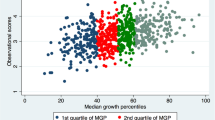Abstract
This article analyzes the impact of class time on students’ grades by using data from Middle Tennessee State University. The data cover a period of six years and are based on a sample of 5803 individuals who enrolled in 133 sections of principles of microeconomics. To identify the causal impact of class time on students’ grades, I used a bootstrapping method which allowed assigning measures of accuracy to sample estimates. For males, the estimated coefficients were negative and statistically significant at the 10% level, and the coefficients suggested that a male student in an afternoon class could expect to earn a letter grade that is 0.029 points lower than he would have earned by taking the class in the morning. For females, the estimated coefficients were not statistically significant.
Similar content being viewed by others
References
Adan, A., & Natale, V. (2002). Gender differences in morningness–eveningness preference. Chronobiology International, 19(4), 709–720.
Anderson, M. L. (2008). Multiple inference and gender differences in the effects of early intervention: A reevaluation of the abecedarian, Perry preschool, and early training projects. Journal of the American Statistical Association, 103(484), 1481–1495.
Arulampalam, W., Naylor, R. A., & Smith, J. (2012). Am I missing something? The effects of absence from class on student performance. Economics of Education Review, 31(4), 363–375.
Beşoluk, Ş., Önder, İ., & Deveci, İ. (2011). Morningness-eveningness preferences and academic achievement of university students. Chronobiology International, 28(2), 118–125.
Borisenkov, M. F., Perminova, E. V., & Kosova, A. L. (2010). Chronotype, sleep length, and school achievement of 11-to 23-year-old students in northern European Russia. Chronobiology International, 27(6), 1259–1270.
Brasfield, D., McCoy, J., & Milkman, M. (1992). The effect of university math on student performance in principles of economics. Journal of Research and Development in Education, 25(4), 240–247.
Cameron, S. V., & Heckman, J. J. (1993). The nonequivalence of high school equivalents. Journal of Labor Economics, 11(1, Part 1), 1–47.
Carrell, S. E., Maghakian, T., & West, J. E. (2011). A's from Zzzz's? The causal effect of school start time on the academic achievement of adolescents. American Economic Journal: Economic Policy, 3(3), 62–81.
Cornwell, C., Mustard, D. B., & Van Parys, J. (2013). Noncognitive skills and the gender disparities in test scores and teacher assessments: Evidence from primary school. Journal of Human Resources, 48(1), 236–264.
Cortes, K. E., Bricker, J., & Rohlfs, C. (2012). The role of specific subjects in education production functions: Evidence from morning classes in Chicago public high schools. The BE Journal of Economic Analysis & Policy, 12(1).
Currie, J., and Thomas, D. (1999). Early test scores, socioeconomic status and future outcomes (No. w6943). National bureau of economic research.
Dills, A. K., & Hernandez-Julian, R. (2008). Course scheduling and academic performance. Economics of Education Review, 27(6), 646–654.
Edwards, F. (2012). Early to rise? The effect of daily start times on academic performance. Economics of Education Review, 31(6), 970–983.
Fryer, R. G., & Levitt, S. D. (2010). An empirical analysis of the gender gap in mathematics. American Economic Journal: Applied Economics, 2(2), 210–240.
Goldin, C., Katz, L. F., & Kuziemko, I. (2006). The homecoming of American college women: The reversal of the college gender gap. The Journal of Economic Perspectives, 20(4), 133–133.
Hernández-Julián, R. (2010). Merit-based scholarships and student effort. Education, 5(1), 14–35.
Holmlund, H., & Sund, K. (2008). Is the gender gap in school performance affected by the sex of the teacher? Labour Economics, 15(1), 37–53.
Husain, M., & Millimet, D. L. (2009). The mythical ‘boy crisis’? Economics of Education Review, 28(1), 38–48.
Jameson Boex, L. (2000). Attributes of effective economics instructors: An analysis of student evaluations. The Journal of Economic Education, 31(3), 211–227.
Kokkelenberg, E. C., Dillon, M., & Christy, S. M. (2008). The effects of class size on student grades at a public university. Economics of Education Review, 27(2), 221–233.
Lavy, V., & Schlosser, A. (2011). Mechanisms and impacts of gender peer effects at school. American Economic Journal: Applied Economics, 3(2), 1–33.
Lumsden, K. G., & Scott, A. (1987). The economics student reexamined: Male-female differences in comprehension. The Journal of Economic Education, 18(4), 365–375.
Murnane, R. J., Willett, J. B., & Levy, F. (1995). The growing importance of cognitive skills in wage determination (No. w5076). National Bureau of Economic Research.
Pascarella, E. T., & Terenzini, P. T. (2005). How college affects students (Vol. 2). San Francisco: Jossey-Bass.
Pekkarinen, T. (2012). Gender differences in education. Nordic economic. Policy Review, 1, 165–195.
Pope, N. G. (2016). How the time of day affects productivity: Evidence from school schedules. Review of Economics and Statistics, 98(1), 1–11.
Raimondo, H. J., Esposito, L., & Gershenberg, I. (1990). Introductory class size and student performance in intermediate theory courses. The Journal of Economic Education, 21(4), 369–382.
Roenneberg, T., Wirz-Justice, A., & Merrow, M. (2003). Life between clocks: Daily temporal patterns of human chronotypes. Journal of Biological Rhythms, 18(1), 80–90.
Siegfried, J. J., & Fels, R. (1979). Research on teaching college economics: A survey. Journal of Economic Literature, 17(3), 923–969.
Tay, R. S. (1994). Students' performance in economics: Does the norm hold across cultural and institutional settings? The Journal of Economic Education, 25(4), 291–301.
Wahistrom, K. (2002). Changing times: Findings from the first longitudinal study of later high school start times. NASSP Bulletin, 86(633), 3–21.
Williams, D. D., Cook, P. F., Quinn, B., & Jensen, R. P. (1985). University class size: Is smaller better? Research in Higher Education, 23(3), 307–318.
Acknowledgements
The author thanks Chris Klein, and Tony Eff for helpful comments and suggestions.
Author information
Authors and Affiliations
Corresponding author
Rights and permissions
About this article
Cite this article
Aldaghir, M.I. Do Morning Classes Improve Student Learning of Microeconomics Principles?. Int Adv Econ Res 24, 163–177 (2018). https://doi.org/10.1007/s11294-018-9680-1
Published:
Issue Date:
DOI: https://doi.org/10.1007/s11294-018-9680-1
Keywords
- Grades
- Class time
- Economics education
- Academic performance
- Microeconomics
- Gender differences
- Course scheduling
- Bootstrapping




